 |
|
||||||
|
|
 |
|
||||||
|
|
Survival English by Peter Viney and John Curtin
The original version pre-dated Streamline and was originally written for courses at ACSE-London and published by Mary Glasgow Publications. When Mary Glasgow ceased promoting course books, John had trouble buying copies for his classes in Brazil, and mentioned the problem to Michael Boyd of Heinemann at a conference in Brazil. Heinemann offered to re-publish the book in a new version. I was keen to see the book looking as good as possible, and suggested Shireen Nathoo as designer. Shireen had worked with my materials for years, including Grapevine II and Grapevine III. We discussed the look of the book at great length. We also decided to do it in American English.
Each unit was keyed to the situational area by a coloured symbol at the top of the page. Sometimes there was one symbol (the unit on 'Lost Baggage' - unit 33 is "Travel"), sometimes there were multiple symbols (unit 17 'Traveling Companions' is about socializing with strangers on a plane, so has two symbols, 'Travel' and 'Socializing.') |
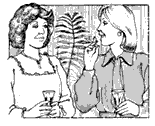 |
Here is an example of a unit that was set in a similar situation in both versions. Two characters have just had dinner with the Managing Director. MGP version, page 22 "Hope you had a good time". You'll notice that in those politically-incorrect days, a character was seen smoking and there's a joke about drinking too much. |
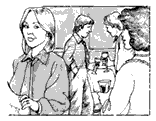 |
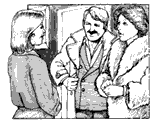 |
| Heinemann version, unit 21 "Courtesies". Alcohol and tobacco no longer feature. In this case, Wilbur's boss has fallen asleep out of sheer boredom (and we've seen the earlier part of the dinner party in unit 20, so we know why). There are very few units this similar! The woman in the photo is Valerie Gossage, who edited the Student's Book. | |||
 |
|||
| Basic Survival by Peter Viney | |||
| Basic Survival was a response to the success of the first book, and we decided to write a 'prequel' - a lower level book that would lead into Survival English. Shireen Nathoo again designed the book. This time, I tied together the storyline a little more, and set it on the Pacific Rim. The story takes place in San Diego, Vancouver and Alaska (which made a change from the normal American settings). I was particularly pleased to be writing to locations that I had recently visited, and was able to use my own photographs in some places. This extract from unit 57 'Skagway' has my pictures on it. | 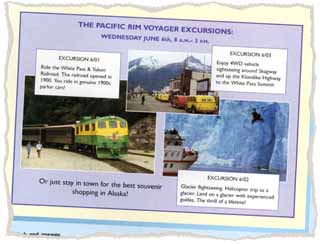 |
||
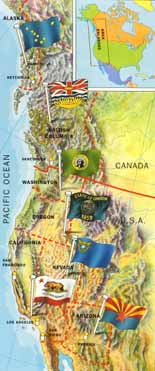
Map from unit 5 |
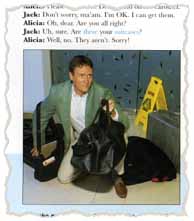 The map in unit 5 'Baggage in Hall' shows where the story takes place.I was very pleased with the way we managed to combine a clear structural point (demonstratives) with a very real situation at the baggage carousel. The map in unit 5 'Baggage in Hall' shows where the story takes place.I was very pleased with the way we managed to combine a clear structural point (demonstratives) with a very real situation at the baggage carousel.
This time there are seven situational areas, spread over 60 units: |
|||
|
I'm particularly proud of Basic Survival. There's a lot of humour / humor in the storyline too. Until we prepared the web site, I had never actually realised that this is the only course book I've done entirely on my own. |
||||
Survival Teacher's Files
These are loose-leaf so that extra material can be added. This was something I had always wanted to do. You can integrate the student pages with teacher's notes, your own notes, and perhaps pictures or pages from the photocopiable resource packs. For added convenience, the CD version of the audio materials can be stored in the file.
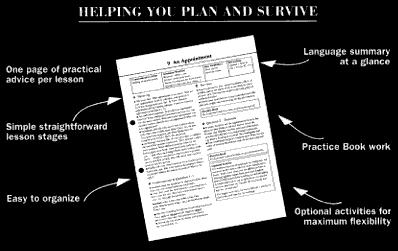
Survival Resource Packs
These resource packs, with photocopiable worksheets for paired activities were developed by Kevin Miller in Nagoya, Japan.
Survival Workbooks
Anne Delestrée prepared the Workbooks for both levels.
Survival Audio
Recordings are available on both CD and cassette.
Go To...
|
| Books | Exercises | Videos | Resources | Home | |